There are many snakes in the world that are black and yellow in color. Some snakes may be primarily yellow or black with patterning such as stripes, blotches, or having a colored belly.
Some snakes also have other colors, but we will be covering snakes that are mainly black and yellow from around the world.
- 1. Mangrove Snake
- 2. Common Kingsnake
- 3. Banded Krait
- 4. Yellow-bellied Sea Snake
- 5. Plains Garter Snake
- 6. Yellow Rat Snake
- 7. Laotian Wolf Snake
- 8. Black-necked Garter Snake
- 9. Eastern Garter Snake
- 10. Rosy Boa
- 11. Eastern Hognose Snake
- 12. Eastern Ribbon Snake
- 13. Bull Snake
- 14. Ring-neck Snake
- 15. California Whipsnake
- 16. Carpet Python
- 17. Western Shovelnose Snake
- 18. Common Watersnake
- 19. Plain-bellied Watersnake
- 20. Eastern Racer
- Other Black and Yellow Snakes
1. Mangrove Snake
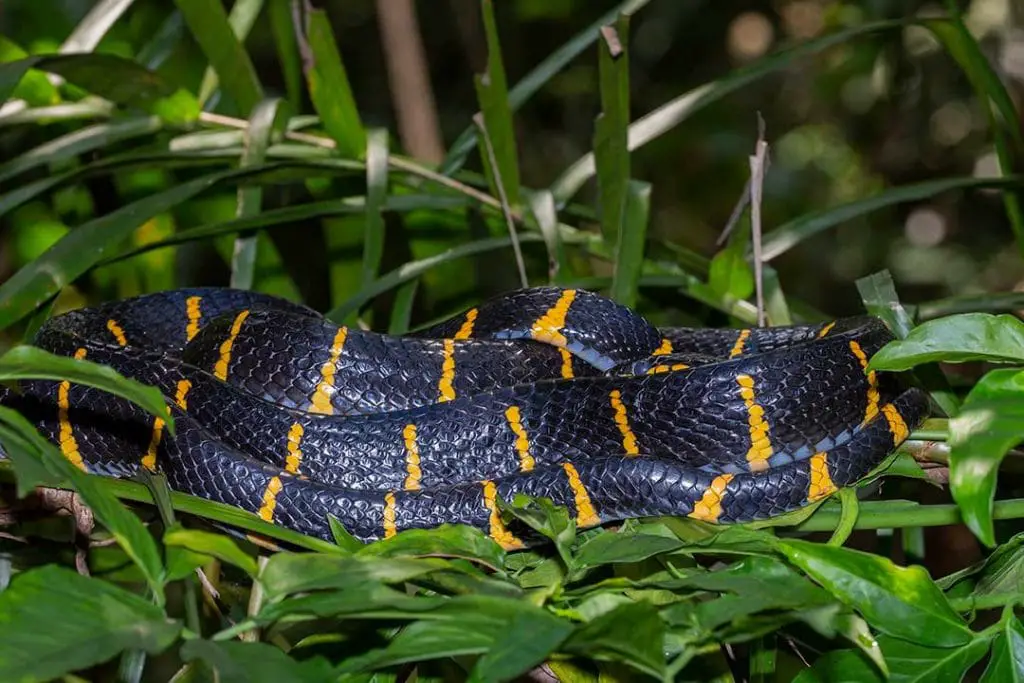
The mangrove snake (Boiga dendrophila) is a rear-fanged venomous member of the colubrid family.
This black and yellow snake is found over much of Southeast Asia, but prefer rainforest habitat over mangrove swamps despite the name.
They are not considered to have medically significant venom, it’s a very mild venom.
While it would not be fun to be bitten by a mangrove snake, these beauties will not put you in the hospital unless you happen to be allergic to their venom.
These snakes are occasionally found in captivity, but they are not easy to find.
2. Common Kingsnake
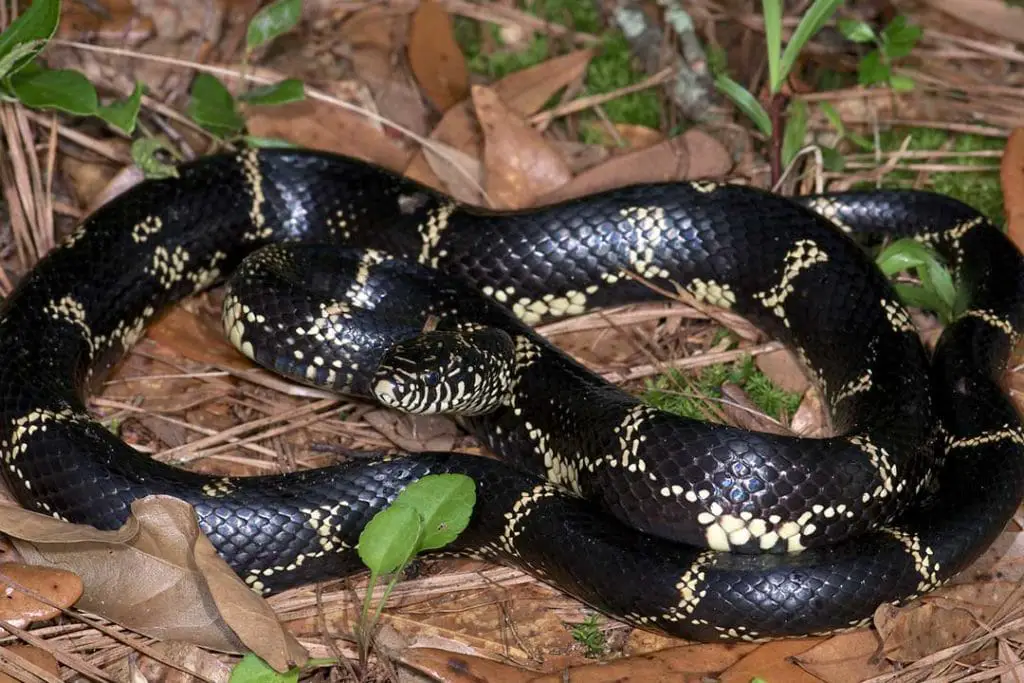
The non venomous common kingsnake (Lampropeltis getula) is a common sight. The species is widespread with populations along most of the East Coast.
The snakes tend to be black with yellow, but the exact pattern depends on the subspecies and location.
Eastern kingsnakes are a glossy black with yellow crossbars while speckled kingsnakes have yellow speckles across the body.
Yellow and black are very common colors for kingsnakes. Kingsnakes are very common pets.
The common kingsnake is considered to be one of the best snakes for beginners since they are tolerant of care mistakes and rarely refuse a meal.
3. Banded Krait
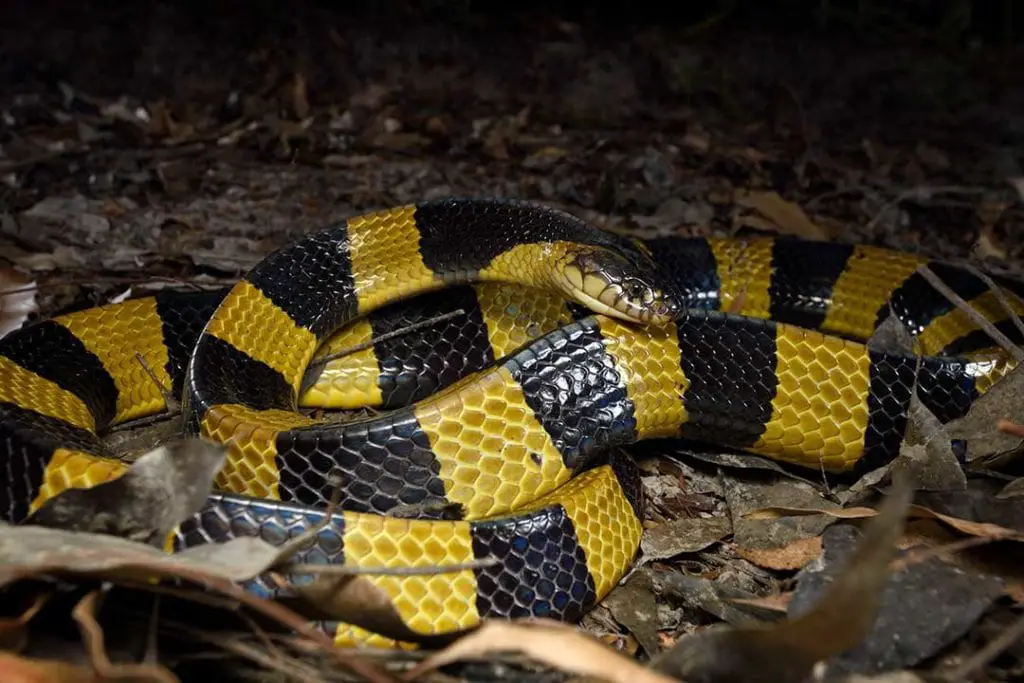
The banded krait (Bungarus faciatus) is a nocturnal snake native to the Indian subcontinent.
They are the largest species of krait with an average length of around six feet and a maximum of seven.
This black and yellow snake is very venomous but rarely bites humans since it is nocturnal and shy.
The black banded krait is typically yellow and black but some animals may have white bands instead.
4. Yellow-bellied Sea Snake
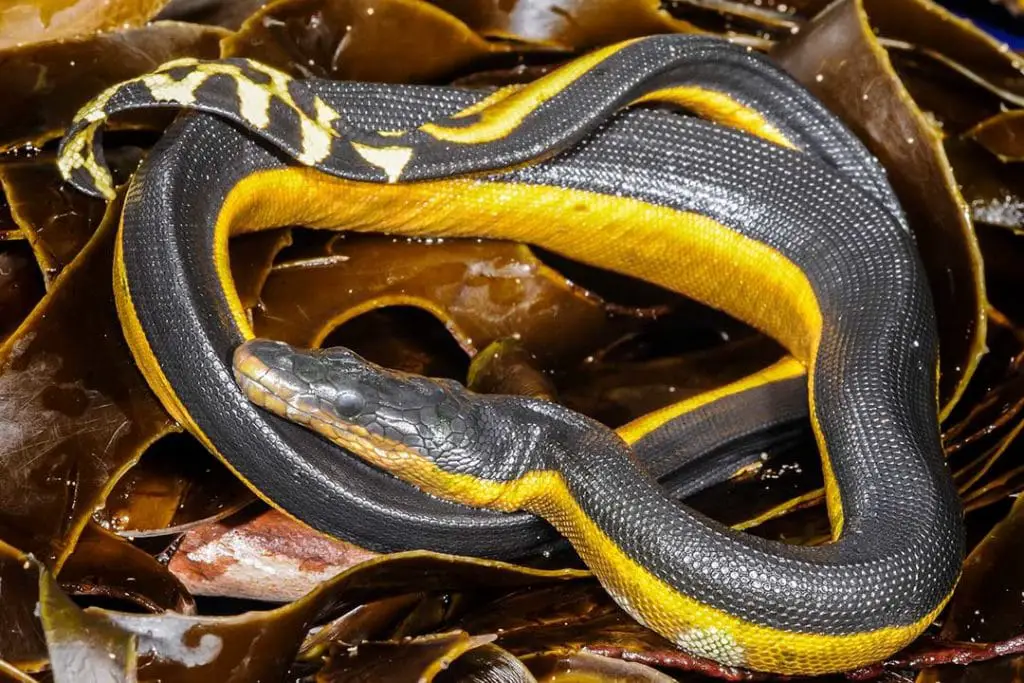
The yellow-bellied sea snake (Pelamis platura) is a venomous sea snake found in warm waters across the Pacific Ocean. These snakes eat fish and hunt by resting at the surface.
They will bite and capture fish passing below them. They are mostly black with a bright yellow belly and a flattened yellow tail.
These snakes give live birth directly in the water.
They are also the fastest swimmers out of the snakes. These snakes tend to stick near areas with plenty of fish not too far from the surface.
They have been found in many countries that border the Pacific Ocean.
5. Plains Garter Snake
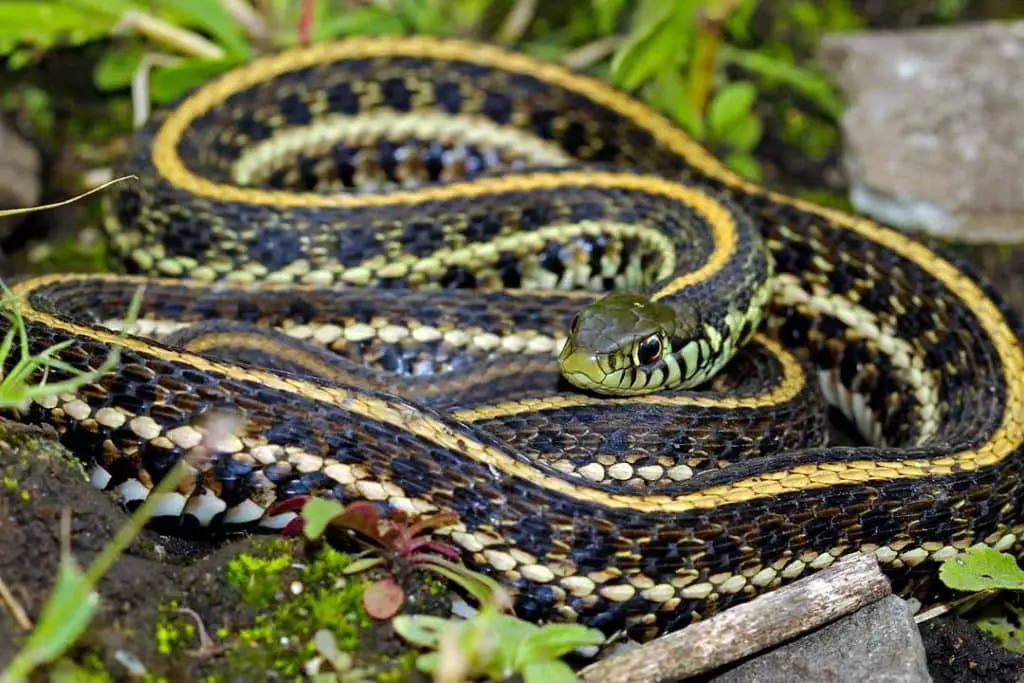
The plains garter snake (Thamnophis radix) is a snake with a dull blackish-green body with yellow stripes going down the length of the animal.
They can be found in the plains of North America from southern portions of Alberta, Canada all the way down to the north of Texas in the United States.
These snakes tend to be 15-27 inches long as adults. This black and yellow snake is most commonly found in meadows and plains with a source of fresh water nearby.
They eat a wide range of prey that can include invertebrates like worms and grasshoppers, fish, rodents, birds, bird eggs, reptile eggs and amphibians.
This garter snake species can be found as a pet, though they are less common than some other species.
6. Yellow Rat Snake
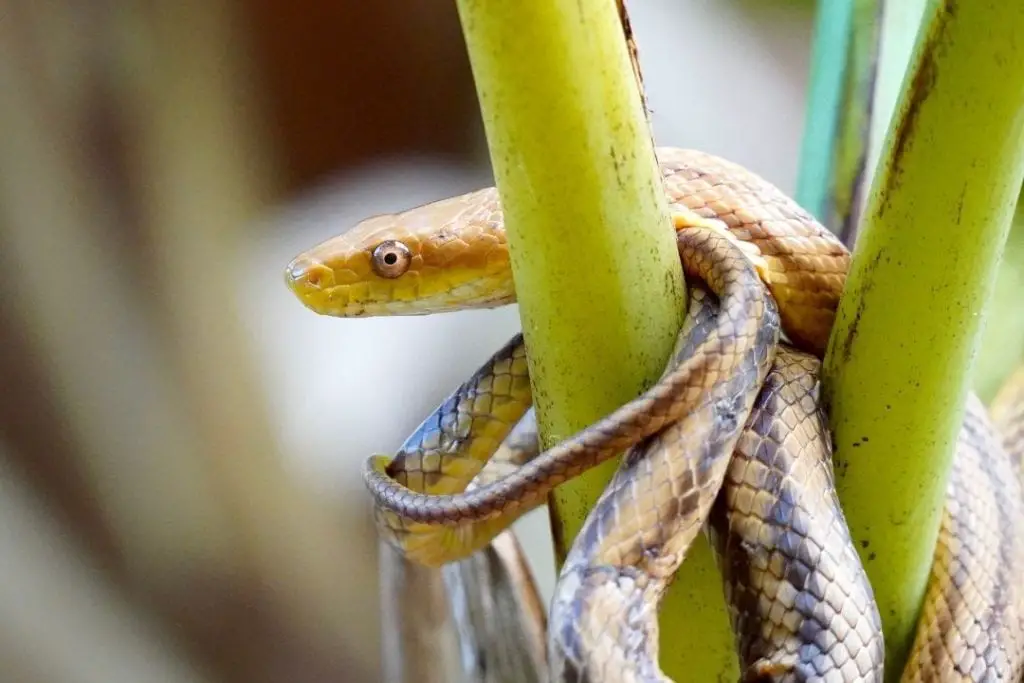
The yellow rat snake (Pantherophis alleghaniensis quadrivittata) is a subspecies of the Eastern rat snake. This subspecies is yellow with black stripes down the body.
Yellow rat snakes are frequently found in trees. They are typically found in the Southeastern United States. They eat warm-blooded prey as adults and cold-blooded prey as juveniles.
7. Laotian Wolf Snake
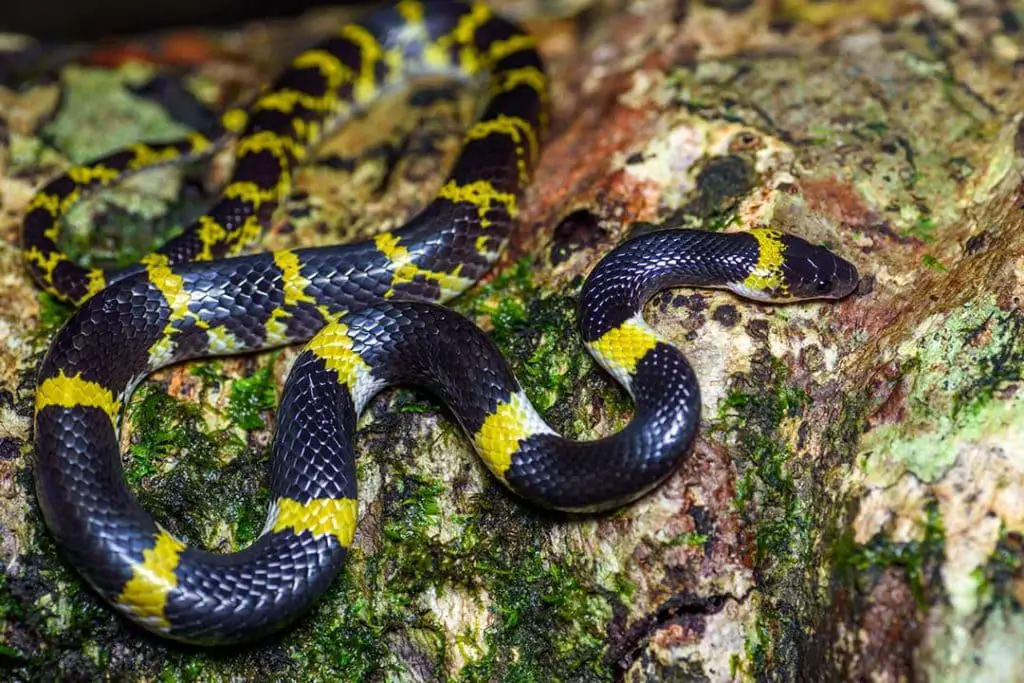
The Laotian wolf snake (Lycodon laoensis) can be found in Laos and neighboring countries in Southeast Asia.
These yellow and black snakes with yellow lips are a small colubrid that tends to be around 20 inches long as adults. They are nocturnal and fairly widespread with regular sightings across their range.
8. Black-necked Garter Snake
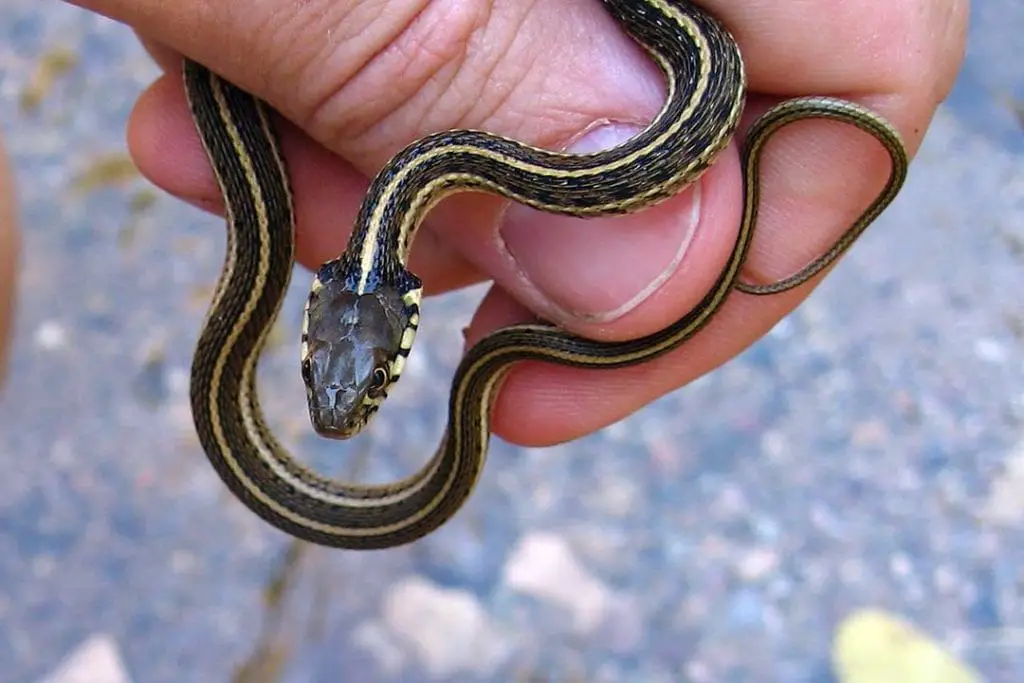
Black-necked garter snakes (Thamnophis cyrtopsis) is a species of garter snake with black blotches and yellow stripes.
The stripe along the spine can be orange, but the side stripes tend to be yellow or tan. They are found in the southwestern United States and go as far south as Guatemala.
They are semi-aquatic and live near streams, ponds, and rocky pools. They are 16-27 inches long as adults.
They eat primarily aquatic prey such as frogs, tadpoles, fish, worms, crustaceans, and skinks.
9. Eastern Garter Snake
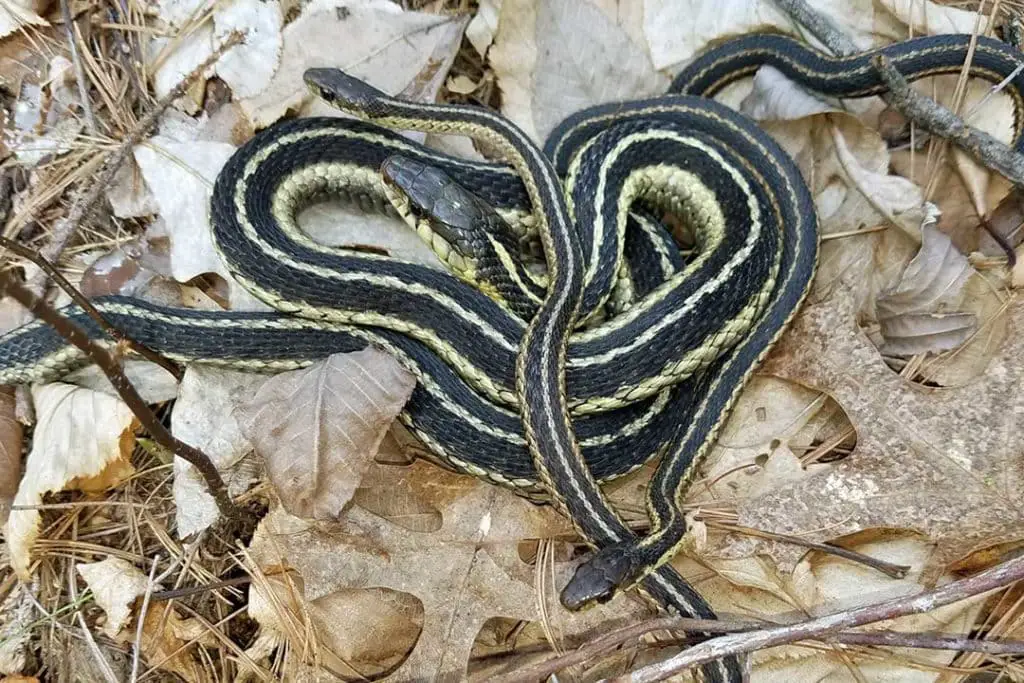
Eastern garter snakes (Thamnophis sirtalis) are a common snake in the eastern portion of the United States. They are typically dark with yellow stripes running down the body.
They live in a wide variety of habitats, but heavily prefer moist meadows. They can also be found near water like many other species of garter snake.
This black and yellow snake is typically 34 inches long on average. Adults can vary between 18 and 53 inches in length. They eat a wide variety of prey that can include amphibians, earthworms, and insects.
They bear live young and are known for their mating behavior. Garter snakes spend the winter in a communal den.
When spring arrives, males exit and wait for the females. The males will crowd around the female and create a mating ball. Garter snakes are popular as pets though they tend to need high humidity.
10. Rosy Boa
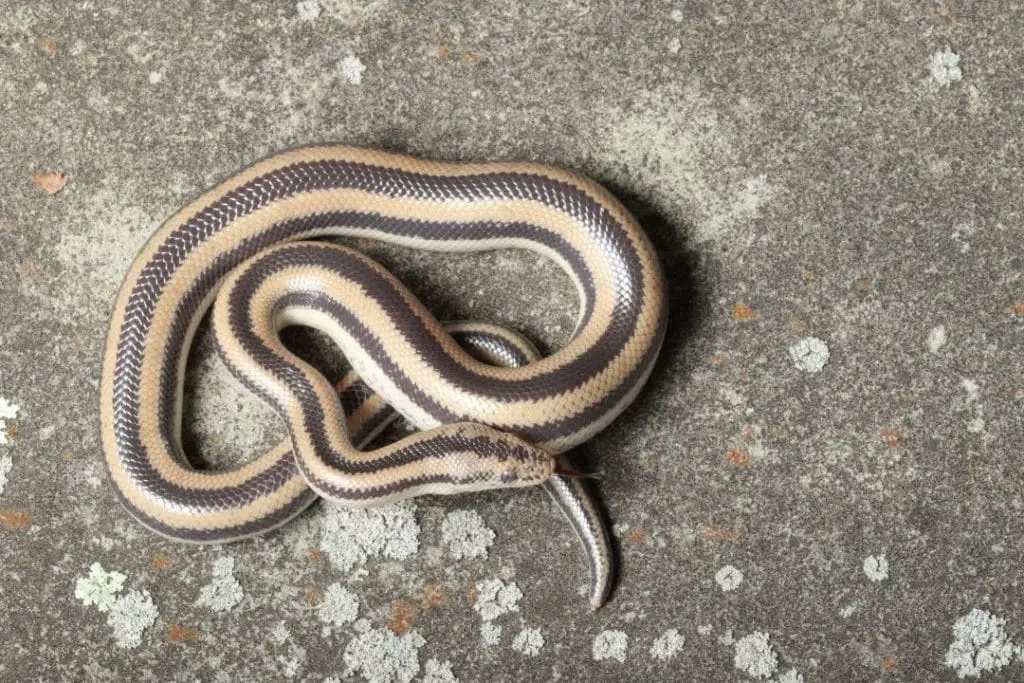
The rosy boa (Charina trivirgata) is a widely variable snake native to California, Arizona, and northwestern Mexico.
They come in a wide variety of colors naturally, with the Mexican rosy boa typically being a light yellow with black stripes.
Some selectively bred morphs may have a stronger yellow. They are very slow snakes that prefer to ambush their prey.
They eat primarily small mammals like kangaroo rats and baby rabbits, but they will eat nearly any vertebrate they can catch.
They are between 16 and 44 inches long but 30 inches is the average. They give live birth and live only in dry habitats such as scrubland and desert areas.
These snakes make good pets since they are very docile and stay small. They spend most of their time in captivity hidden since they are mainly active at night.
11. Eastern Hognose Snake

Eastern hognose snakes (Heterodon platirhinos) are a burrowing snake found mainly in the United States.
Their range covers 30 states in the east and central portions of the country. While not all snakes are yellow and black, it is a common color in some parts of its range.
These are burrowing animals that prefer areas with loose or sandy soil. The black and yellow snake can be 17-41 inches long as adult.
They have a wide diet but prefer to eat toads. They are resistant to the toxins found in most toads. They are rear-fanged venomous, but their venom is not hazardous to humans.
12. Eastern Ribbon Snake
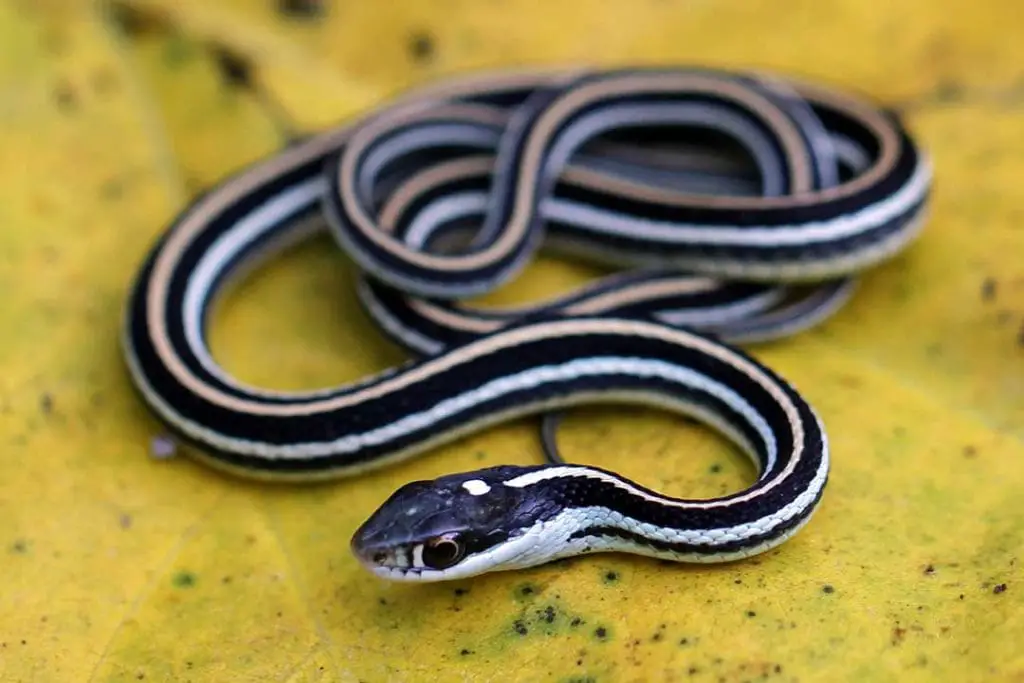
The Eastern Ribbon Snake (Thamnophis sauritis) is a relative of the garter snake found in North America. They are found mainly to the east of the Mississippi River.
They are easy to confuse with garter snakes since they share nearly identical markings and body structure, with a yellow stripe running down their body.
Ribbon snakes do tend to be thinner and have their stripes begin at a different scale row. These snakes are typically found in open fields that are either very wet or near a body of water.
They eat primarily frogs, salamanders, and their young. They will also eat fish but will not pursue it. Ribbon snakes can be found as pets.
They tend to be easy to keep if you can find prey small enough for young snakes.
Like other garters, you need to be careful with the prey to avoid parasites and vitamin deficiencies.
Common feeder fish like goldfish contain an enzyme called thiaminase that causes a Vitamin B1 deficiency and causes neurological problems in affected snakes.
13. Bull Snake

The bull snake (Pituophis catenifer sayi) is a subspecies of the gopher snake.
While many gopher snakes are a light yellow or tan, bull snakes tend to have a more intense yellow along with black markings.
The bull snake is one of the largest snake species in the United States. They can reach lengths of up to 8 feet.
They have a very wide range and can be found from Canada all the way down to Mexico. Bull snakes have a wide diet and will eat amphibians, lizards, birds, and mammals.
Since this black and yellow snake is very good at climbing, it can eat a whole nest of birds in one sitting.
They are occasionally kept as pets but are more difficult due to their personality when young and the mess they make.
Bull snakes will tame down but they produce a lot of waste that can be hard to clean since they tend to spread it around the enclosure.
14. Ring-neck Snake
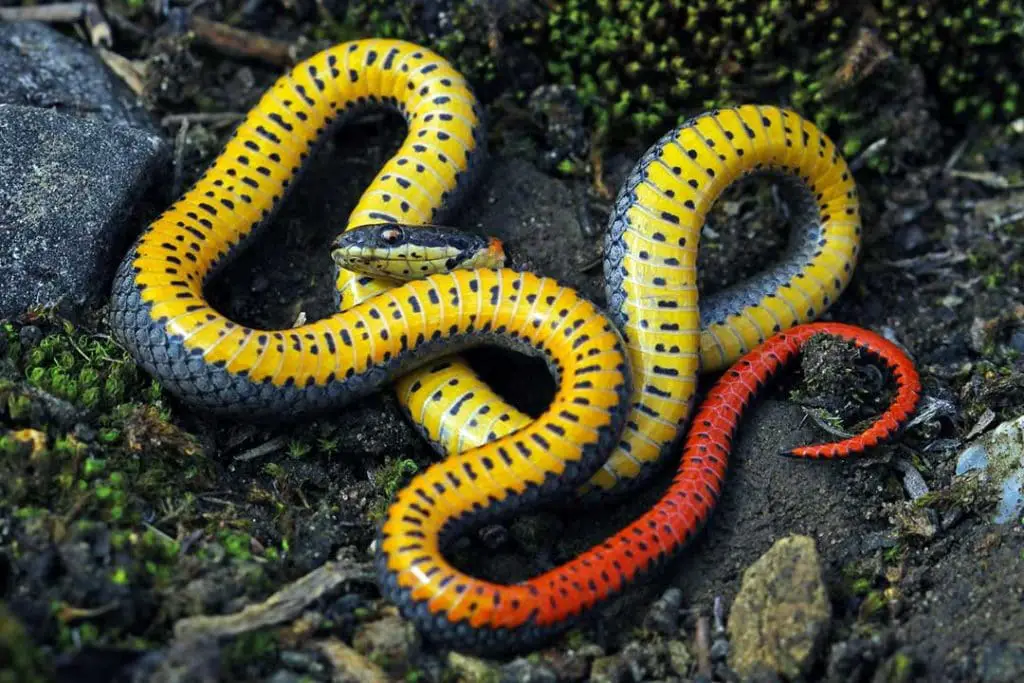
The ring-neck snake (Diadophus punctatus) is mainly black with a yellow ring around the neck.
They have bellies that can be anywhere from red to yellow. They’re found in the eastern and central portions of North America and have a wide range.
Ring-neck snakes are nocturnal and rarely seen in the open. They are unusual in that they can live in colonies with over 100 individuals.
The ring necked snake is very small and thin. They can be between 10 and 18 inches long as adults. These snakes are rarely kept in captivity since they do not live for more than six years.
Wild snakes easily reach 10 years old and may live to be 20.
They are constrictors and eat frogs, salamanders, lizards, earthworms, and young snakes. Some populations only target one prey species such as the red-backed salamander.
15. California Whipsnake
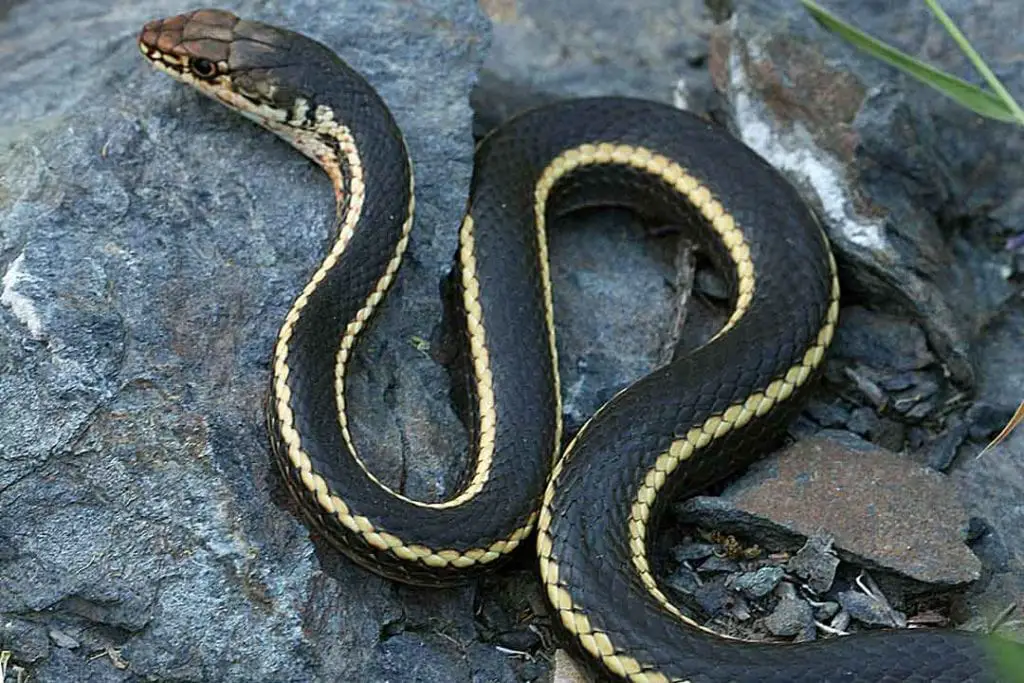
The California whipsnake (Masticophis lateralis) is also called the California striped racer.
They live in California and Baja California. They are typically between 3 and 4 feet long including the tail. They are easily identified by the yellow stripes on a dark brown or black background.
The California whipsnake with its characteristic yellow stripe has a wide diet that consists of lizards, insects, small mammals, snakes, and birds.
This black snake with yellow stripes heavily prefer lizards. They hunt by chasing down their prey and swallowing it alive. They are diurnal snakes and very active.
16. Carpet Python
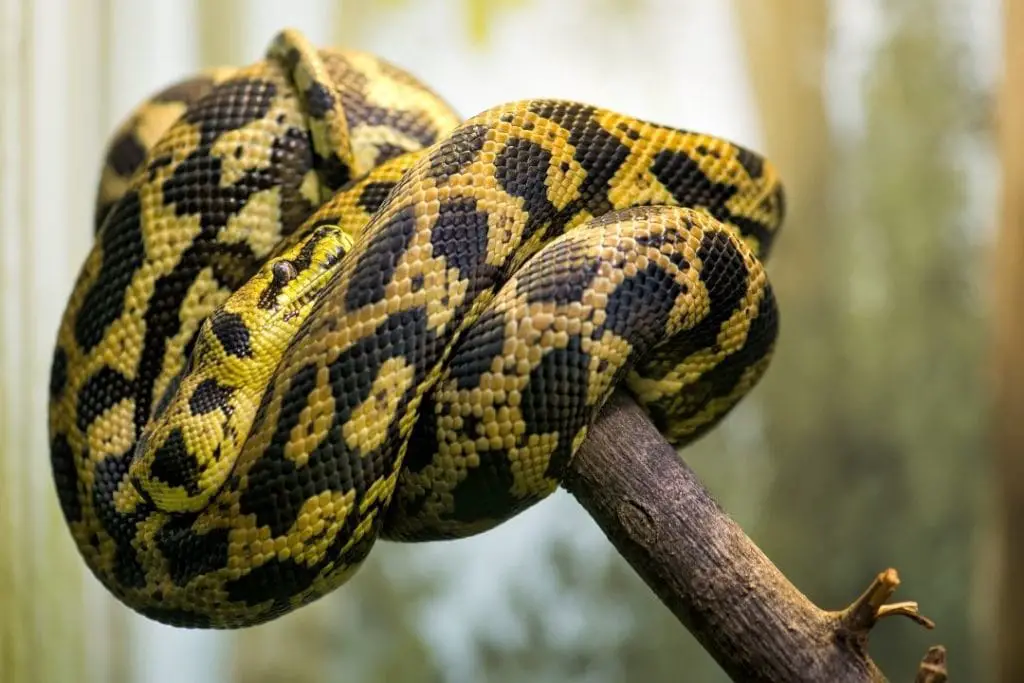
Many subspecies of Carpet python (Morelia spilota) are black and yellow. Jungle and diamond carpet pythons are cat eyed snake species known to come in black and yellow in the wild.
These are common pet snakes in their native Australia and many morphs exist. They are typically around 6 feet long but some subspecies can reach over 10 feet long. The record is nearly 13 feet.
These dark yellow and black snakes prefer to stay in trees but will use open areas to bask. Their diet consists mainly of mammals, birds, and lizards in their native habitat.
Captive animals may eat rats but some large snakes are fed whole chickens or rabbits to maintain a healthy weight.
Like other pythons snakes species, female carpet pythons will care for their eggs. They coil around their clutch of 10-50 eggs and shiver to raise the temperature and incubate the eggs.
Once the eggs hatch, the young snakes are capable of catching their own meals immediately.
17. Western Shovelnose Snake
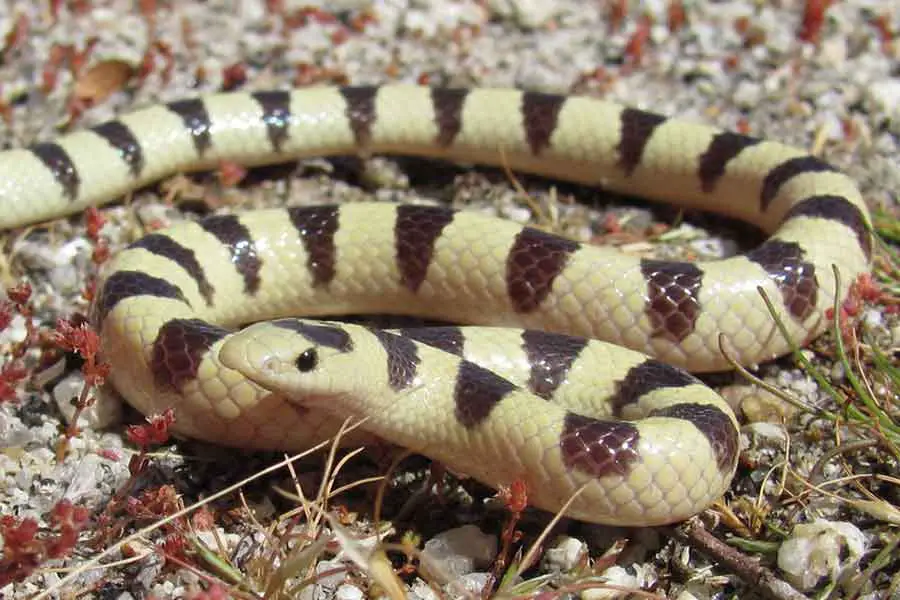
The western shovelnose snake (Sonora occipitalis) is a colubrid snake found in the southwestern United States and Mexico.
They are typically yellow or cream with black saddle markings along the back. They are 11-17 inches long and have shiny scales without a keel.
Western shovelnose snakes are burrowing snakes that prefer loose, sandy soils. They spend their days underground and come out at night.
They eat Invertebrates like scorpions, spiders, centipedes, and other insects and their larva. They are rarely seen but may occasionally be spotted crossing roads at night.
18. Common Watersnake
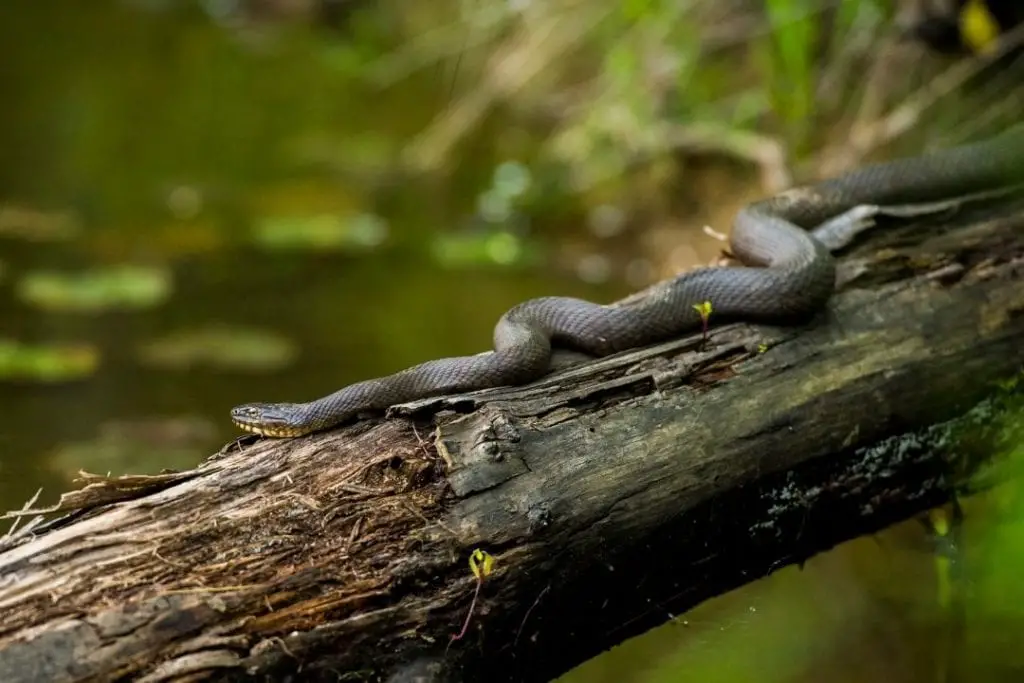
The common watersnake (Nerodia sipedon) is a common sight along waterways in eastern North America.
Adults can darken in color to be black and they may have yellow bellies. This depends on the individual and they are very diverse in appearance.
They typically sun themselves on branches that overhang water. They eat a wide range of prey but tend to prefer aquatic prey.
They range from 24-55 inches long. They are occasionally kept as pets but need a deep water feature and plenty of dry land.
This makes housing the species a challenge. It can be done, but most typical snake owners do not have the space needed to keep the species healthy.
19. Plain-bellied Watersnake
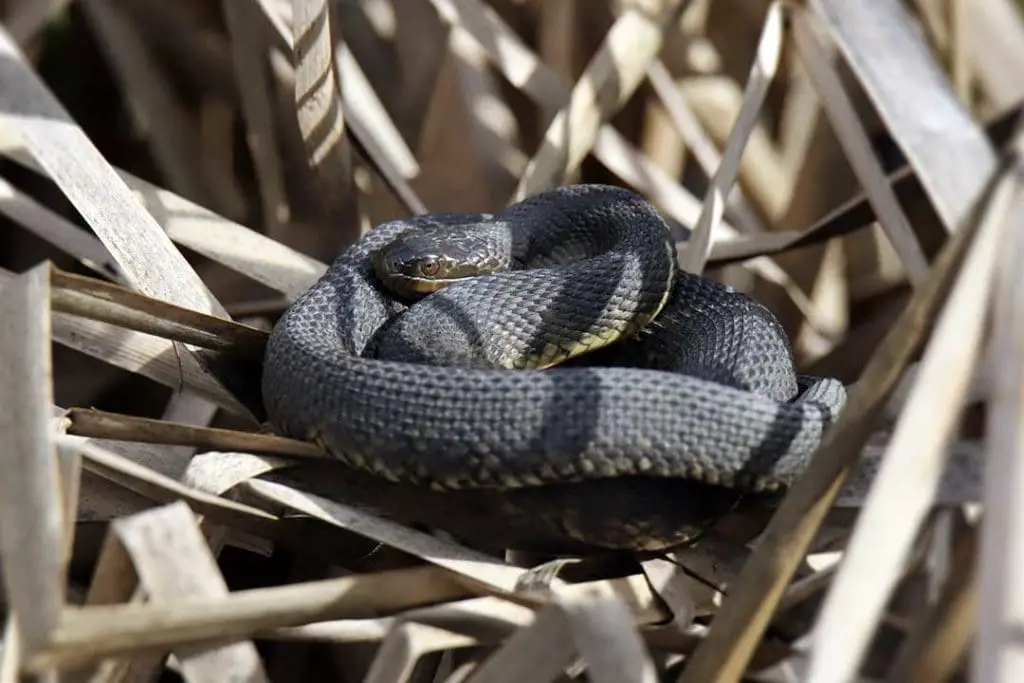
The plain-bellied water snake (Nerodia erythrogaster) is another watersnake that can be found over a wide range of the United States. Some subspecies also live in Mexico.
They tend to be dark as adults with yellow bellies that lack markings. They are 30-64 inches long and live in many habitats close to freshwater.
They will range further from water than other members of the genus. They give live birth and will only eat cold-blooded prey such as fish and amphibians.
Northern populations of this species are considered threatened or endangered. This is due to habitat loss in any areas and mistaking young snakes for venomous snakes like cottonmouths.
20. Eastern Racer
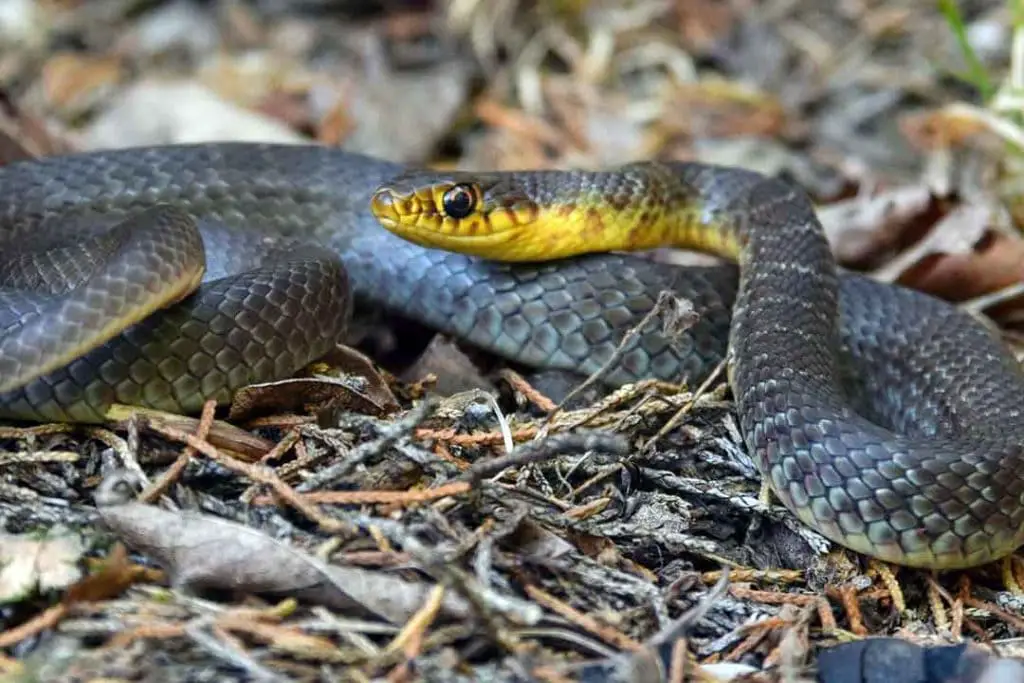
The eastern racer (Coluber constrictor is a wide-spread snake found over much of North America from Canada to Guatemala.
They can be a number of colors depending on the location. One of the more common colors is a shiny black with a yellow belly.
They prefer habitats that are dry and open but still have easy access to cover to help the snakes escape predators. They are 35-75 inches long.
This species lays eggs and frequently uses communal nest sites that can include other species of snake. Eastern racers have a very wide diet and eat nearly anything they can catch.
They catch prey by pressing it down with a loop of its body while it swallows them.
Juveniles rely on camouflage to avoid predators while adults employ a unique motion to escape their predators not often seen in other snakes.
They will also bite if cornered. Despite the name, Eastern racers max out at about four miles per hour, which is a brisk walk for an average person.
Other Black and Yellow Snakes
Many species have black and yellow but may include other colors. Eastern coral snakes include bands of red and they have many mimics, some non venomous snakes try to imitate them.
Many venomous snakes also have bright yellows contrasted with dark colors to warn that they are dangerous, like the texas coral snake.
Species like ball pythons and corn snakes or the gold ringed cat snake can have captive-bred colors and patterns that are primarily yellow and black.
Some species may also have yellow and black individuals appear even if the typical snake doesn’t always have those colors.
This can be due to genetic mutations affecting the black and yellow pigments. Some animals may also lack red pigments common to the species.
Many popular morphs of captive snakes originated from unusual wild individuals. You may also see animals that look more yellow from species that are typically a light brown or tan like the salt marsh snake.
We hope this has taught you more about black and yellow snakes. If you know of other species of black and yellow snakes, please leave a comment below.
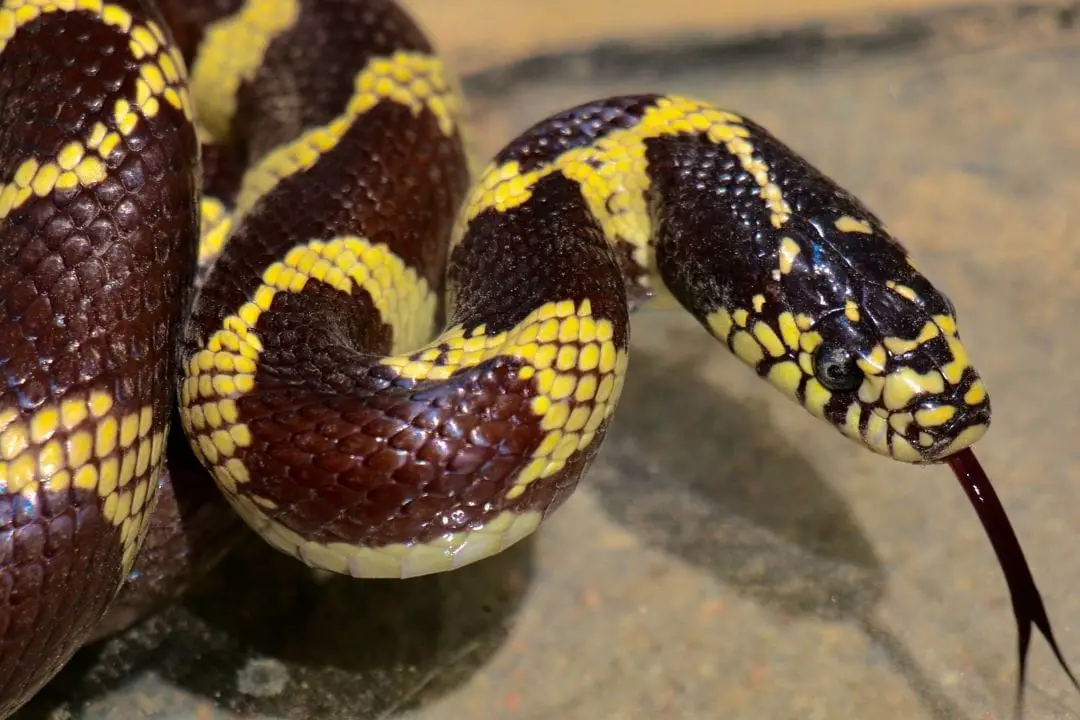
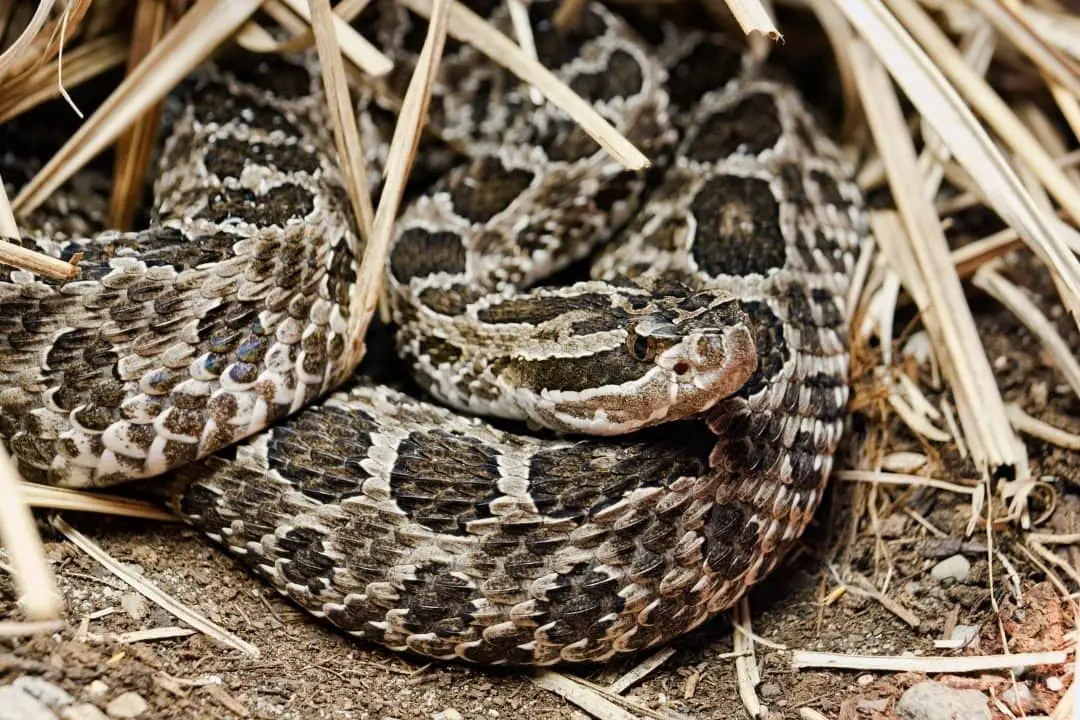
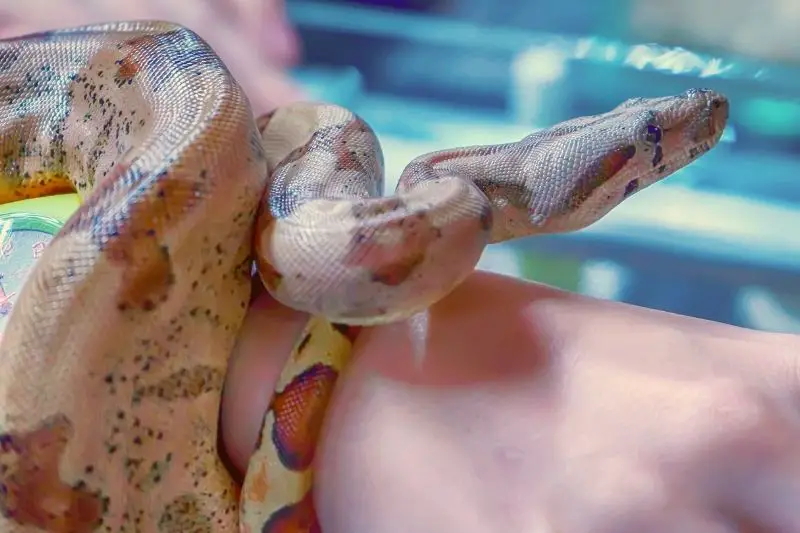
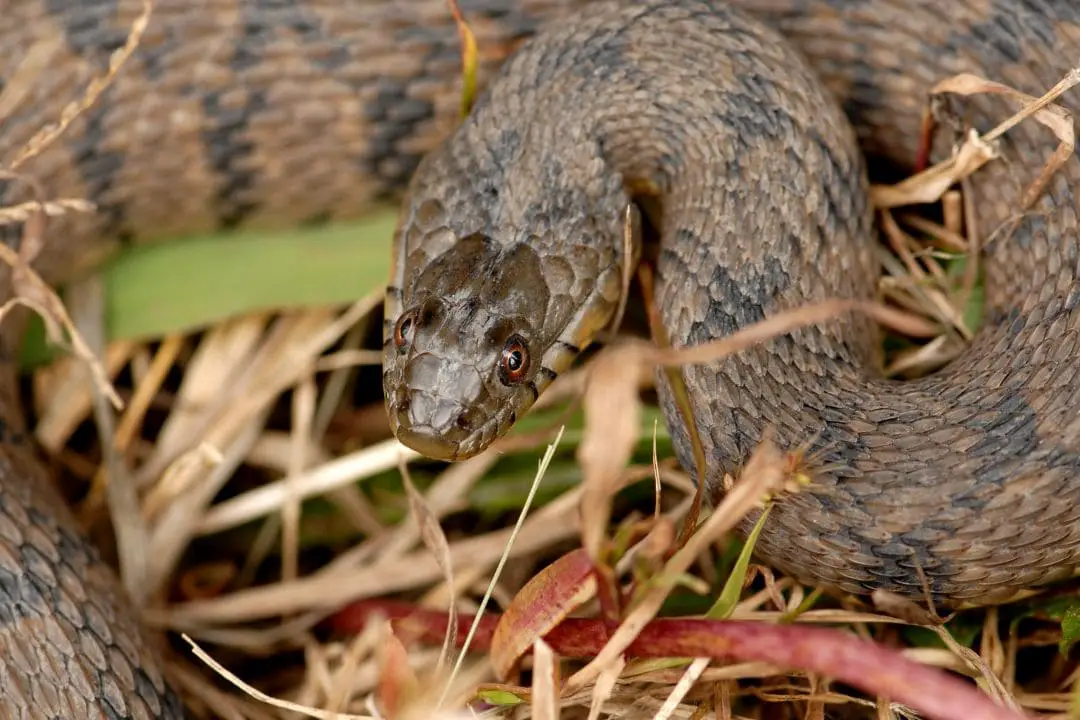
I reside in PG County Maryland, while raking leaves in my back yard I saw a snake about 2feet long about big around as my index finger that was bright yellow with black bans around it’s body,it resemibles the picture you show of the western shovelnose snake, but your article says there found only in the southwestern US and Mexico , So how could one be this far east are they migrating???